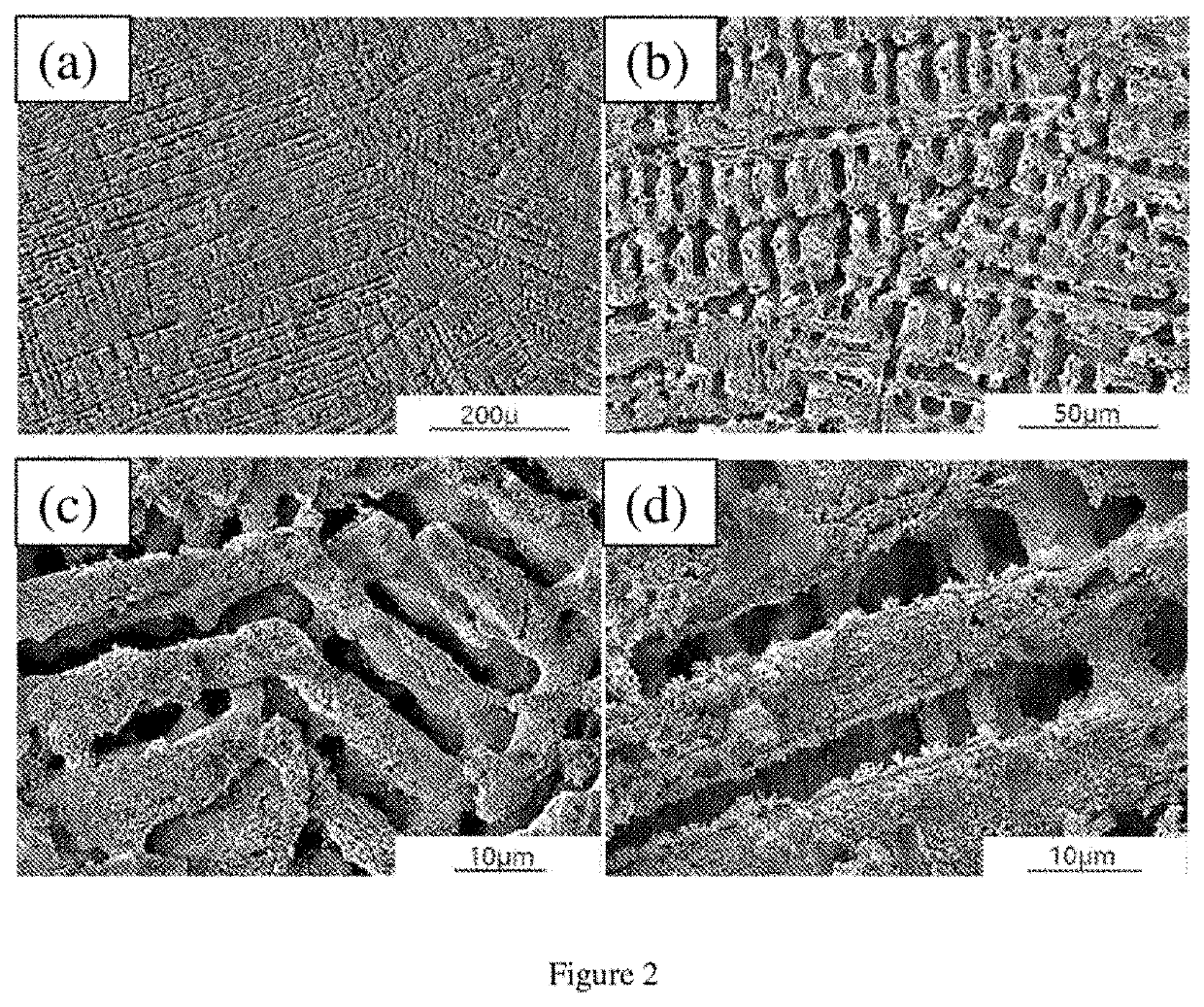Metal structures
a metal structure and metal technology, applied in the field of metal structure obtaining method, can solve the problems of limiting the practical applicability of metal structure, exposing the structure's mechanical fragility, and inherently poor mechanical stability of metal structure, and achieves the effects of reducing tortuosity, reducing mechanical fragility, and superior fluid permeability
- Summary
- Abstract
- Description
- Claims
- Application Information
AI Technical Summary
Benefits of technology
Problems solved by technology
Method used
Image
Examples
example 1
[0097]The alloy melt was prepared by assembling the raw materials in a water-cooled crucible. The crucible was evacuated and partially backfilled with inert gas prior to being heated under reduced pressure until the materials were molten.
[0098]Suction-cast arc-melted precursor alloy rods were sectioned into small circular disks for repeatable data. Two alloy systems containing different noble metals (Cu30Mn70 and Au30Co70) were used as precursors. Nanoporous Cu disks of equal geometry were produced by free corrosion in 1M HCl, while nanoporous Au samples were produced by free corrosion in 10M HNO3.
[0099]FIGS. 1(a)-(c) show pictures of different steps of an embodiment method of the invention. FIG. 1(a) shows precursor alloy disks obtained by sectioning solidified alloy rods. FIG. 1(b) shows as-dealloyed porous copper disks. FIG. 1(c) shows an image of one of the samples immersed in the dealloying solution. The image refers to the chemical dealloying process to selectively remove Mn f...
example 2
ty Characterisation
[0106]Contact angle measurements were conducted on dealloyed Cu structures obtained in accordance with the procedure described in Example 1. Measurements were conducted on a KSV CAM 200 Tensiometer under standard conditions.
[0107]Contact angle measurements confirmed that the tested copper samples are super-hydrophilic, with contact angle of 0° (as shown in FIG. 6(b)) relative to a contact angle of 76.8° measured on dense Cu samples (as shown in FIG. 6(a)). With regard to the porous Cu structures it is evident from the test that water droplets rapidly wick into the sample structure and evenly disperse in all directions due to large capillary forces due to the multi-modal porosity of the sample structure.
[0108]Super-hydrophilicity can be particularly useful for maximum wicking and surface wetting in applications such as heat transfer (i.e. for surface rewetting yielding maximum heat transfer coefficient and heat flux removal), and for wicking of water (i.e. for evap...
example 3
rial Tests
[0109]The antibacterial properties of dealloyed Cu structures, obtained in accordance with the procedure described in Example 1, were examined. Specifically, the antimicrobial activity towards a representative bacterium, Staphylococcus Aureus, was examined. Stainless steel and dense Cu were used as negative and positive controls, respectively.
[0110]Serial dilution, agar plating and colony counting was performed in order to accurately quantify the remaining viable bacteria after exposure to metal substrates of the invention and the reference controls. FIG. 7(a)-(c) show serial dilution and plating of Staphylococcus Aureus bacteria on Tryptic Soy Agar (TSA) plates after 2 minutes of incubation with exposure to (a) stainless steel (b) dense copper and (c) porous copper disks obtained in accordance with the invention. For each petri dish shown in FIGS. 7(a)-(c), each quadrant represents a dilution factor, ranging from 1 to 10−3. Group of colonies (5×10 uL droplet of bacterial ...
PUM
| Property | Measurement | Unit |
|---|---|---|
| temperature | aaaaa | aaaaa |
| cross-sectional size | aaaaa | aaaaa |
| size | aaaaa | aaaaa |
Abstract
Description
Claims
Application Information
 Login to View More
Login to View More - R&D
- Intellectual Property
- Life Sciences
- Materials
- Tech Scout
- Unparalleled Data Quality
- Higher Quality Content
- 60% Fewer Hallucinations
Browse by: Latest US Patents, China's latest patents, Technical Efficacy Thesaurus, Application Domain, Technology Topic, Popular Technical Reports.
© 2025 PatSnap. All rights reserved.Legal|Privacy policy|Modern Slavery Act Transparency Statement|Sitemap|About US| Contact US: help@patsnap.com



